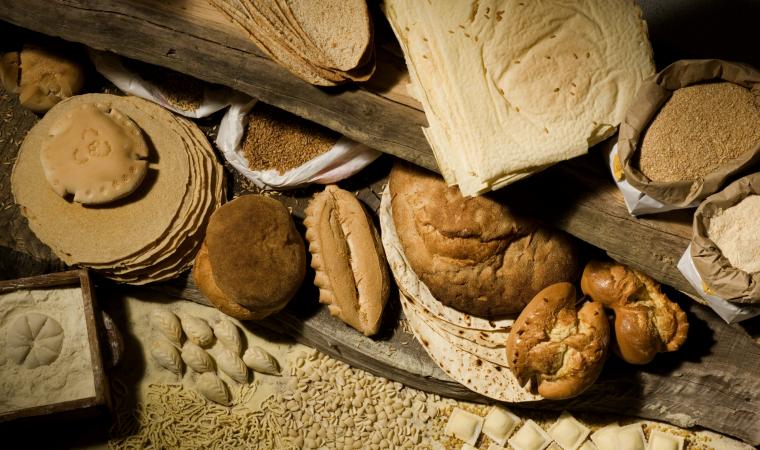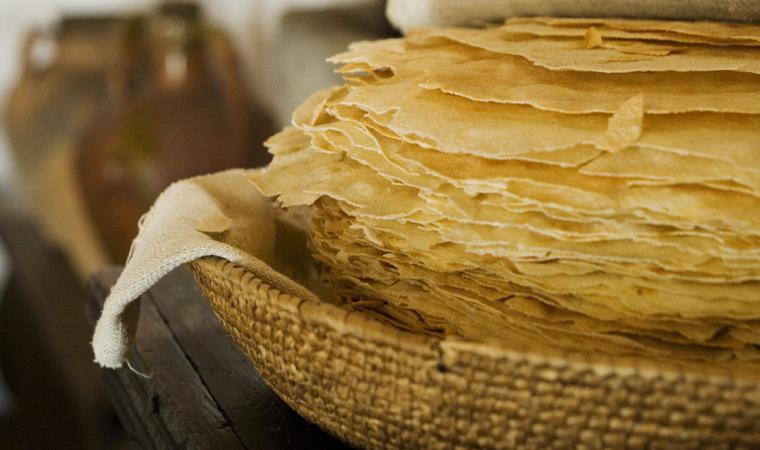
Sardinian cuisine reflects thousands of years of stratified culture, with added value brought by the extensive production of traditional desserts. The names, shapes and details of the recipes vary depending on the territories, but the basic ingredients are identical, simple and aromatic. The result is a variety of delicacies, like the famous seada or sebada, made of two disks of pastry, one on top of the other, with a tangy, stringy cheese filling, flavoured with lemon or orange peel. After frying in boiling oil, it is drizzled with honey, preferably strawberry tree honey, and served hot and crispy. Its origins are in the agro-pastoral culture of Barbagia, when the shepherds returned home after the transhumance, welcomed by the warmth of the family. The biscuits of Fonni, similar to sponge fingers but softer and flavoured with lemon or vanilla, are perfect for every occasion. In the Campidano area, the pastries are known as pistoccus. They are made from eggs, sugar and flour. The is pistoccheddus grussus are dry, light, crumbly biscuits and are ideal for breakfast. They come from the villages around Monte Linas, where they are called gallettinas. For an afternoon snack, there’s nothing better than a ricotta cake or an ancient dessert known as su papai biancu, already made in the Middle Ages in Cagliari: a milk pudding sweetened with almonds and lemon.
Amaretti are a must for all celebrations. They are small, crispy, golden ‘treasure chests’ with unique flavours. They are made from sweet and bitter almonds, mixed based on precise and essential proportions. In the north of Sardinia, an extra ingredient added to the mixture of almonds, egg whites and sugar is sapa, or ‘vincotto’ (cooked wine), a common addition to the desserts and pastries made for All Saints’ Day. Starting with pan’e sapa, an ancient example of bread ‘turned into’ a dessert, widespread in the lower Campidano and Nuoro areas. It is characterised by long leavening, is dark in colour and has a strong flavour of cooked must and cinnamon. It has a round shape, like a cake. Closely linked to the first of November are sos ossus de mottu (bones of the dead), while sos pabassinos (central-northern area) or is papassinus (in the south) were originally autumn cakes, but are now used ‘for every occasion’. The name comes from papassa, raisins that enrich the mixture of flour, eggs, lard, almonds and walnuts. These shortbread biscuits have an unmistakable flavour, are covered with icing and silver sprinkles or brushed with egg yolk before cooking. In the Campidano area, they are flavoured with cinnamon, vanilla or sapa and in the Barbagia area and Logudoro with citrus peel, wild fennel seeds or aniseed.
Sas tiliccas are also made in November, originally in the central-northern area, and are now made everywhere with various names, among which the famous caschettas of Belvì stand out. A very thin sheet of crispy violada pastry with an almond and honey (or sapa) filling, with orange peel and saffron. The shapes vary: horseshoe, heart, spiral or letters. In Dorgali and Mamoiada, they are made for the celebration of the Fires of St. Anthony), as along with another delicacy: su pistiddu, with a filling made of sapa, and also the typical copulettas, cakes of Ittireddu and Ozieri, with their distinctive crescent shape. Their origin is linked to weddings and baptisms: the initials of the bride and groom or the christened child are cut into the cake. A typical Christmas sweet is torrone, a soft, very sweet type of nougat. Tonara is its home. The first mention of su turroni tonaresu was at the end of the 19th century. Over time, it became a speciality famous throughout the nation. The characterising element is honey - wildflower, strawberry tree or eucalyptus - melted over a low heat in a copper pot. The dough is stirred for four hours, without sugar. Then almonds or hazelnuts or walnuts are added. You will be able to discover the art of making this nougat at the torrone festival, on Easter Monday, in Tonara. Meanwhile, in Oristano, is mustazzolus are made. These are ‘mostaccioli’, very soft diamond-shaped biscuits, flavoured with cinnamon and lemon, with icing on top. They are perhaps the oldest Sardinian biscuit: at one time, the leavening lasted two weeks, a characteristic that differentiated them from the ‘mostaccioli’ biscuits of the Italian peninsula.
Easter is the time for casadinas. The name comes from casu, fresh cheese with a ‘decisive’ taste, used in Barbagia and Logudoro for their filling, along with raisins. In the Sassari area and in Gallura, they are known as casgiaddine and casgiatini (‘formagelle’ - soft cheese). In the Campidano and Sulcis areas, ricotta is more commonly used instead of cheese and is flavoured with lemon and saffron, without raisins. The name is sas pardulas, ‘little baskets’ of thin pastry with a soft ‘heart’ inside and a sprinkling of icing sugar on top. Also typical of the Campidano area are is pirichittus, shortcrust pastry covered with crunchy lemon-flavoured icing. They can be empty inside, like the pirichittus de bentu or filled with almond paste, like the pirichittus prenus or a matza de mindua. The is pistoccheddus de cappa o incappaus are similar and are covered with white icing. They are made into different shapes: the most famous are is pistoccheddus di Serrenti, shaped like animals. For Easter, they are also made with eggs, a sweet version of su coccoi cun s’ou, a bread made in various shapes enriched with hard-boiled eggs. Known also as marigosos, suspiros, giarminos and gesminus, the bianchini (or bianchetti) resemble the meringues made in other regions but have a different flavour and consistency. They look like a wavy, rippled pyramid, white and crumbly with a soft, creamy filling. They are made by beating the egg whites until stiff, with sugar, lemon and almonds. Then they are decorated with silver or coloured sprinkles.
The pastries used for ceremonies are masterpieces, decorated by the able hands of sas drucceras, the pastry-chef housewives. They are the emblem of is pastissus, made in the Cagliari area: little cakes made of very thin pastry with a soft almond filling. They are embellished with floral decorations called s’indoru and are so refined that they are also called little royal cakes. At Borore, in the Marghine region, they become capigliettas, while in the upper Oristano area, they are timballinas. Is candelaus emanate a sense of solemnity. They are little almond cakes shaped like small candles or shoes, used for christenings, confirmations and weddings. The gueffus or ‘sighs’, are a must at ceremonies. They are little balls of almond paste with a full-bodied and refined flavour, sprinkled with sugar and wrapped in coloured paper like sweets. A smaller version exists in Barbagia: sos bucconettes (bocconcini - meaning morsels), with hazelnuts instead of almonds. The aranzada is used at christenings and weddings in Barbagia and the orange flavour is enhanced with the sweetness of honey and crunchiness of almonds. Masterpieces made of almonds, with the fragrance of lemon. These are gattò, mentioned by Grazia Deledda and also made into monumental compositions. Sos coriccheddos (little hearts) are beautiful pastries of Nuoro, as are the durches de s’isposa that brides would receive as a gift from their mother-in-law, mother or godmother. Honey, the undisputed protagonist of desserts from Barbagia, is also used in Goceano, for example in sos pinos, round pastries made with honey and fried.
Intense flavours and fried foods are typical of Carnival on the Island. Is zippulas, the ‘zeppole’ pastries of Campidano, are delicious fritters, long in shape, with a base made with saffron and citrus peel and flavoured with Vernaccia wine. They become sas cattas in Barbagia, li frisjoli in the Sassari area and frisgioli longhi in Gallura. With varying recipes and shapes, is parafrittus or ‘frati fritti’, called ‘fatti fritti’ (fried facts) by mistake, are round with a hole in the middle. The fritters are sometimes filled with custard or honey with the aroma of filu ‘e ferru or abbardente (Sardinian brandy spirits). Sos rujolos are very tasty fried cheese balls, typical of the Nuoro area. Ruioli, arrubiolos, orrubiolus are variants with different names and territories. The name brings to mind ravioli and returns in southern delicacies: is cruxioneddus de mindua are small fried ravioli with an almond filling, sometimes replaced by custard or ricotta. Specialities linked to the agro-pastoral world, especially to domestic pig breeding, are is culingionis de sambene dulche, which have a filling made of ‘sanguinaccio’ (sweet pig’s blood). The ones that children love the most are li acciuleddi, which come from the Gallura region: fried batter shaped like braids, covered with honey (or sugar) and coloured sprinkles. In some towns they become mangadagas or trizzas, similar to spaghetti soaked in honey, folded and rolled up into a twist. The orillettas are similar and are a Sardinian version of chiacchere (angel wings) pastries made in other regions. They come from Baronia but can be found everywhere. They are crunchy and delicious, cheerful and light, like the festive atmosphere they create.














